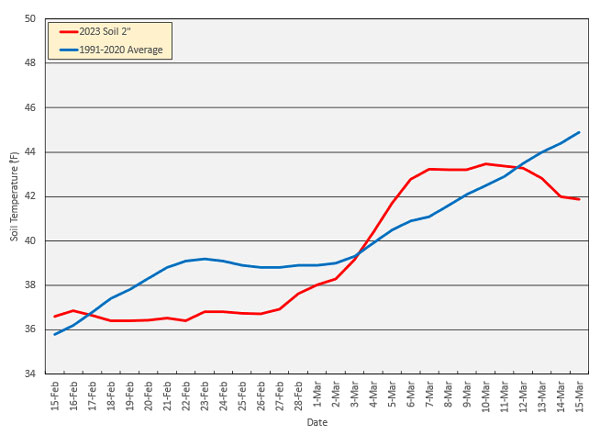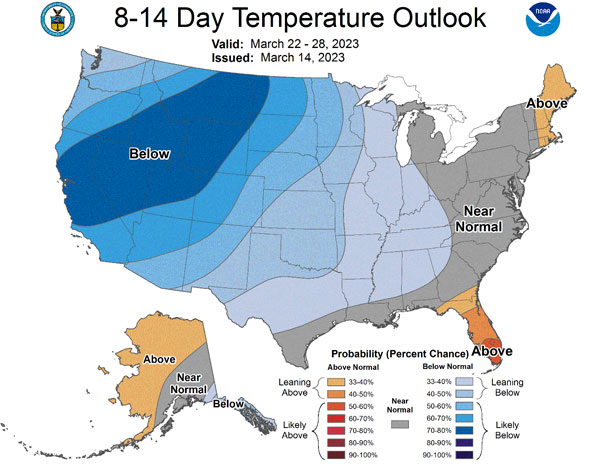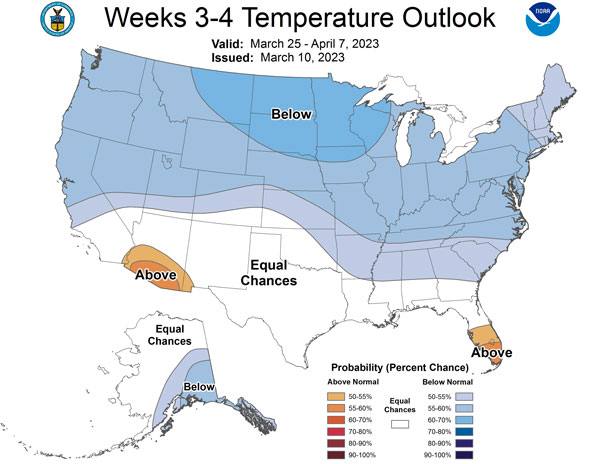We are now two weeks into meteorological spring. Warmer air temperatures are fast approaching, and those will lead to warming soil temperatures. One important benchmark for spring planting is the arrival of soil temperatures that reach and consistently stay above 50°F. As of March 15, no location in Kansas is at or above that threshold at the 2-inch soil depth (Figure 1). Are we ahead or behind normal this year in the race to reach 50°F? Let’s take a closer look.

Figure 1. Average 2-inch soil temperature (°F) across the Kansas Mesonet network for the 7-day period ending at 12 PM CDT on March 15, 2023.
For this report, we will define “soil temperatures consistently above 50°F” as a 7-day average soil temperature at the 2-inch depth of at least 50°F. We can find the average date this occurs using data from the Kansas Mesonet. There are 12 Kansas Mesonet sites with over 30 years of soil temperature data. If we limit the data to the period 1991-2020, as NCEI does for calculating average air temperatures, we can calculate 30-year normals for these 12 locations for every day of the year (Table 1). To generate a statewide average for a 7-day period, we can average both spatially and temporally across the daily averages at each of these sites.
Table 1. 7-day average 2-inch soil temperatures (°F) at selected Kansas Mesonet sites, based on 1991-2020 data. Dates listed are the last date of the 7-day average period. Yellow/orange shades indicate the threshold of 50°F was reached or exceeded.
|
|
Mar 1 |
Mar 6 |
Mar 11 |
Mar 16 |
Mar 21 |
Mar 26 |
Mar 31 |
Apr 5 |
Apr 10 |
Apr 15 |
Apr 20 |
|
Manhattan |
39 |
41 |
42 |
45 |
48 |
49 |
50 |
52 |
53 |
55 |
58 |
|
Colby |
37 |
39 |
41 |
43 |
45 |
47 |
48 |
51 |
52 |
53 |
55 |
|
Garden City |
40 |
42 |
44 |
46 |
48 |
50 |
51 |
53 |
54 |
55 |
57 |
|
Hays |
38 |
40 |
42 |
45 |
46 |
48 |
50 |
51 |
52 |
55 |
57 |
|
Hutchinson |
42 |
43 |
45 |
48 |
49 |
51 |
52 |
53 |
54 |
56 |
58 |
|
Ottawa |
41 |
44 |
46 |
48 |
50 |
52 |
52 |
55 |
56 |
58 |
60 |
|
Parsons |
40 |
41 |
43 |
45 |
47 |
49 |
50 |
52 |
53 |
55 |
57 |
|
Rossville |
36 |
38 |
40 |
43 |
46 |
47 |
49 |
51 |
52 |
53 |
56 |
|
Scandia |
39 |
40 |
42 |
45 |
48 |
49 |
50 |
52 |
54 |
55 |
57 |
|
Silver Lake |
38 |
39 |
42 |
45 |
48 |
49 |
50 |
52 |
54 |
55 |
58 |
|
St John |
38 |
41 |
43 |
45 |
47 |
49 |
50 |
52 |
53 |
54 |
56 |
|
Tribune |
41 |
43 |
44 |
47 |
49 |
50 |
51 |
53 |
54 |
56 |
58 |
|
STATEWIDE AVERAGE |
39 |
41 |
43 |
46 |
47 |
49 |
50 |
52 |
53 |
55 |
57 |
Using the Mesonet data, the first date on which the statewide 7-day average 2-inch soil temperature reaches 50°F is March 31. This is an increase of 11 degrees from the average of 39°F on March 1, and four degrees warmer than the March 16 average of 46°F. During March, soil temperatures typically rise quickly, in response to warmer air temperatures. Any locations where the ground is still frozen also thaw quickly thanks to the higher sun angle. But 2023 has thrown us a curveball, as we are currently in an extended period with below-normal air temperatures. Back in late February, the state was on average running around 2°F below normal (Figure 2), in part due to frozen ground beneath significant snow cover in the northwest. February 23 and 24 were particularly cold, with lows in the single digits above and below zero at most locations. A quick warmup ensued on February 26 and lasted into the beginning of March. In response, soil temperatures began increasing. By March 6, the state was running around 2°F above normal, and it looked as if we were well on our way to an early beginning to the growing season. But cold air returned on the 6th, and by March 15, soil temperatures were decreasing, and we are back below normal again.
Short-term temperature forecast for Kansas
We look to fall even further behind normal in the coming weeks. The 8 to 14-day outlook from the Climate Prediction Center (Figure 3) favors below-normal air temperatures into late March, and the outlook for the following two weeks (Figure 4) indicates below-normal air temperatures are favored into early April. Should these two forecast maps verify, it will further delay 2-inch soil temperatures reaching 50°F across the state, and thus the growing season will be starting later than normal this year.
You can monitor March’s march towards 50° soil temperatures on the Kansas Mesonet’s web site at the following URL: http://mesonet.k-state.edu/agriculture/soiltemp/. Here you will find current readings as well as 7-day minimum, maximum and average soil temperatures at both the 2-inch and 4-inch depths for over 75 sites across Kansas.

Figure 2. Statewide 7-day average 2-inch soil temperatures across the Kansas Mesonet in 2023 along with average 30-year normals from 1991-2020. Dates listed are the last day of the 7-day average period.

Figure 3. The Climate Prediction Center’s 8 to 14-day air temperature outlook, valid for the period March 22-28, 2023.

Figure 4. The Climate Prediction Center’s air temperature outlook for the period March 25-April 7, 2023.
Matthew Sittel, Assistant State Climatologist
msittel@ksu.edu
Tags: climate soil temperature